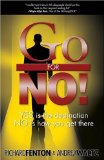Are You Using Failure to Achieve Success?
By Joy Bing Fleming, MBA
We all have to face rejection and failure at some point in our lives. In Richard Fenton and Andrea Waltz’s best selling book, Go for No!, they explain how to fail your way to success. Get ready because everything you thought you knew about failure is about to change. Open your minds to a new and different way of thinking.
The first thing to understand is the basic failure/success model. Like most people, this used to be my model:
Failure <---------- ME ----------> Success
I was in the middle between success and failure, and I always tried to move towards success and avoid failure. However, I didn’t realize that by avoiding failure, I was actually avoiding success. You’re probably thinking – “What are you talking about? That doesn’t make sense.”
Let me explain. The correct model is:
ME ———-> Failure ———-> Success
Failure is actually the halfway point on the road to success. This concept was an eye opener for me and definitely made me think differently. When most people fail, they give up (and consequently, they don’t reach success). Instead, they should embrace failure. You’re probably thinking “embrace failure? – that’s a strange concept.”
Failing and becoming a failure are 2 different things. Successful people understand that failing leads to success, and they fail willingly and enthusiastically. On the other hand, unsuccessful people avoid failure. One of the ways many people have become a success is by earning a degree, and you can click here to find out about Online Classes.
Babe Ruth is a great example of the Go For No! concept. He has the record for the most homeruns in baseball history. However, he also has the most strikeouts in baseball history. He didn’t give up when he had all of those strikeouts. He knew that all of those failures would lead to success. And guess what, we don’t focus on his failures, we remember his successes. We always hear about Babe Ruth’s 714 homeruns, but we never focus on his 1330 strikeouts.
In the book, Go for No!, they talk about a company who gives out rewards to the top selling salesperson and to the salesperson who received the most “no’s.” Believe it or not, this is usually the same person. The person that hears the word “no” the most (in other words, the person that fails the most) is usually the same person that succeeds the most (just like Babe Ruth).
Don’t get discouraged by your failures. Embrace them. Learn from them, and understand that they are the half way point on the road to success.
30 Minute “Exploration” Session.

Thomas Edison counted his one hundred failures at developing the light bulb as learning experiences on his way to success. Aren’t we glad he didn’t give up after his 99th failure?
I usually don’t usually post on many Blogs, nevertheless I just has to say thank you… keep up the amazing work. Ok unfortunately its time to get to school.
that link went a bit wrong, it should read: http://goingdownwriting.wordpress.com/2010/03/17/failure-the-art-and-science-of-perfection/
thanks
Love it, it reminds me of my own take on failure as a tool for success from a while back: Failure: the art and science of perfection http://bit.ly/
Keep up the good work!
best regards
This is an excellent post. Thanks.
Hi Chris. Thank you for your comment. I applaud you for wanting to learn more about How to Fail Your Way to Success. The 1st time I read the book, Go for NO!, I had the same response as you – “what?” However, after I read it again, it started to make alot of sense. The concept really does work. I would recommend that you Click Here!, and take a look at the book. It will definitely give you a better understanding.
Whhaaaaaattttt??
If someone says”no”, you must say”next”